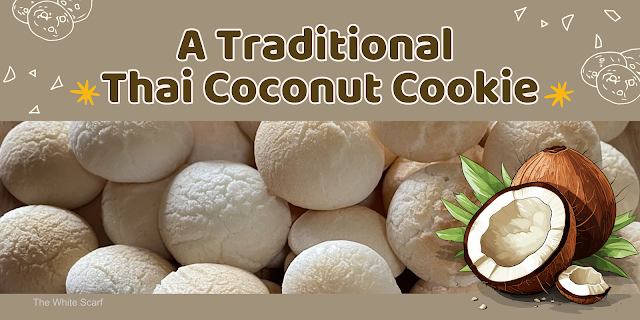Kanom Phing (ขนมผิง): A Traditional Thai Coconut Cookie
Introduction
When I think about baked goods, the first thing that comes to mind is Kanom Phing (ขนมผิง). The moment I open a tin filled with these tiny, round cookies, a familiar coconut aroma takes me back to childhood afternoons spent at my grandmother’s house. She always had a jar of Kanom Phing on her kitchen shelf, ready to be shared with guests over a cup of tea. These delicate, crumbly treats have been a part of Thai culture for generations, offering a nostalgic sweetness that melts in your mouth the moment you take a bite.
Origins and Cultural Significance
Kanom Phing (ขนมผิง) is a traditional Thai cookie known for its delicate, crumbly texture and light coconut aroma. This bite-sized treat is popular in Thailand, especially during festive occasions and as an afternoon snack with tea. Made primarily from coconut milk and tapioca flour, Kanom Phing has a unique, melt-in-your-mouth consistency that makes it a beloved dessert among Thai people.
Kanom Phing has roots in Thailand’s old royal cuisine and is often linked to Portuguese influence, much like other Thai desserts that incorporate egg yolks and coconut milk. The cookie is traditionally baked until dry and slightly crispy on the outside but crumbles easily when eaten, releasing a delightful coconut fragrance.
Key Ingredients
The main ingredients of Kanom Phing include:
- Tapioca flour – Gives the cookie its light, powdery texture.
- Egg yolks – Contribute to the richness and structure.
- Coconut milk – Adds a creamy, aromatic flavor.
- Sugar – Provides sweetness and balance.
- Baking powder (optional) – Used in some variations for a slightly puffier texture.
How It's Made
- Mixing the Dough – Egg yolks are beaten with sugar until creamy, then combined with coconut milk. Tapioca flour is gradually added to form a soft dough.
- Shaping the Cookies – The dough is rolled into small balls, typically about the size of a marble, and arranged on a baking sheet.
- Baking – Kanom Phing is baked at a low temperature until it turns slightly golden and develops a crisp shell while remaining crumbly inside.
- Cooling and Storing – The cookies are left to cool before being stored in an airtight container, allowing the flavors to develop further.
Taste and Texture
Kanom Phing is known for its light and powdery consistency. When eaten, it dissolves quickly in the mouth, releasing a rich coconut flavor with a mild sweetness. Some versions include a hint of vanilla or pandan for extra aroma.
Serving Suggestions
- Enjoyed as a snack with Thai tea or coffee.
- Traditionally stored in decorative tins and given as gifts during festivals.
- Sometimes paired with ice cream or other Thai sweets for a fusion dessert.
Conclusion
Kanom Phing remains a nostalgic favorite for many Thais, symbolizing a connection to traditional home baking and cultural heritage. With its simple ingredients yet exquisite taste, this delightful coconut cookie continues to be a cherished treat across generations.


